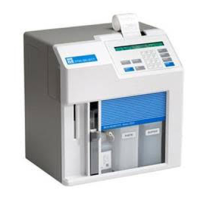4-11
)
This is a direct reading of choline in solution at the enzyme sensor. The enzyme Choline
Oxidase is immobilized in the YSI Choline Membrane.
Choline + 2O
2
Chol Oxidase
2H
2
O
2
+ Betaine
System Buffer YSI 2357
Calibrator Std YSI 2772
Linearity Std YSI 2773
Black Probe YSI 2771(Choline Oxidase Membrane)
White Probe n/a *
Sample Size 25 µL
Cal Station Station #1 Cal Well
Black Probe Parameters
Chemistry Choline
Unit of Conc mg/L
Cal value 175
End Point 30 sec
* If you have a dual channel unit, either Black or White, or both Black and White probes can be
configured for this chemistry.
Note: See Appendix A if concentration unit conversion is required.
Special Considerations:
»
If sample dilution is required, use reagent water or 2357 Buffer.
»
Although the YSI 2772 Choline calibrator solution is prepared using choline bitartrate,
the concentration is expressed as mg/L of choline cation. If you prefer to express the
sample as a salt of choline, you must enter an “adjusted” calibration value when
configuring your instrument measurement parameters.
For example, to express results as a choline hydroxide value, program the calibrator
value as 204 mg/L when using the YSI 2772 Choline Standard calibrator solution. Your
results will now reflect the concentration of choline hydroxide in the sample.
Assumptions and calculations are as follows:
choline hydroxide FW = 121.2
free choline FW = 104.2
(121.1 ÷ 104.2) x 175 mg/L = 203.55 = 204 mg/L (rounded up)
Equivalent values for other choline salts may be calculated in a similar manner.
Potential Interferences. Tests with equimolar concentrations of various vitamins, and other
ingredients of nutritionals, showed little or no interference. On a scale where Choline = 100%,
those substances that produced more than 0.5% response were Riboflavin (1.1%), Pyridoxine
(1.5%), Ascorbic Acid (0.8%), and Thiamine (1.3%). Vanillin, an artificial flavor ingredient,
may produce interference levels exceeding 10% (mole/mole), and should be tested separately
for your individual formulations if known to be present.

